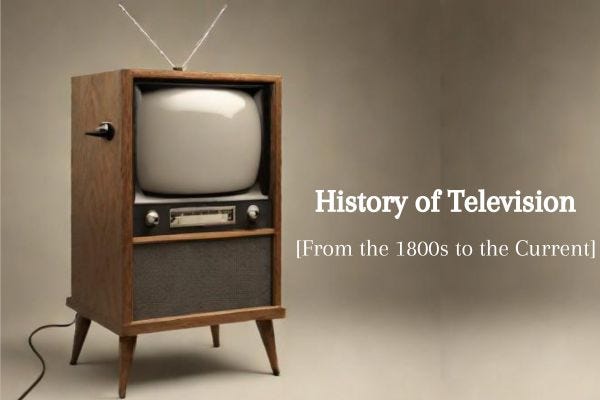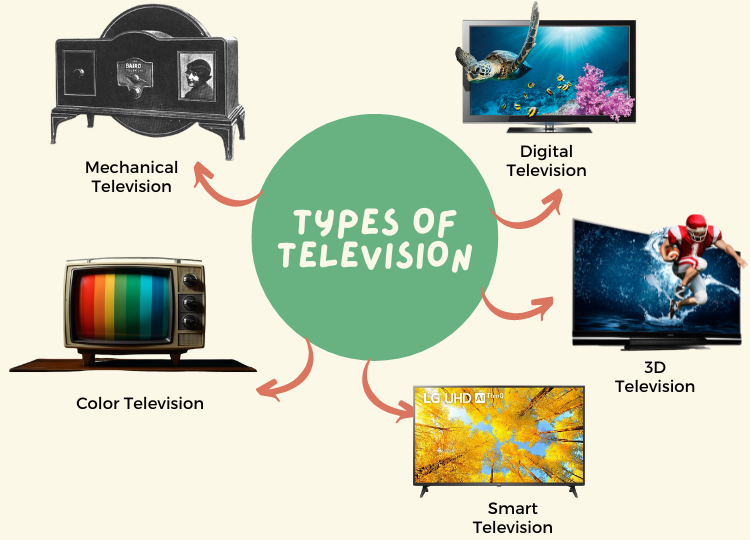A Brief History of Televisions [From the 1800s to Current]


From being a scientific curiosity to a global phenomenon, television has gone through many stages of transformation in its lifetime!
But what marks the start of the history of televisions?
The idea of the television device started in the late 1800s but only saw a successful demonstration in the early 1900s. Since then it went from mechanical to color to digital television in a couple of decades. The technological boom in the 2000s helped television advancement the most. And with the help of internet technology, it is reaching new heights every day.
This is just a summary. Keep reading as we uncover more about the journey of our favorite ‘pass-time companion’ in the following segments-
History of Televisions
Television's history goes back to the late 19th and early 20th centuries. From discovering ways to capture moving pictures to transferring them, televisions have gone through many stages of development. Let's have a look at them closely-
Early Developments
The idea of creating a technology to watch or see moving pictures with sounds was conceived long before the actual invention.
But Inventions such as the cathode ray tube by Karl Ferdinand Braun and the mechanical scanner system by Paul Nipkow were the foundation of television technology in the late 1800s. These two inventions were the building blocks for the electronic TV.
Invention of Electronic Television
The next big step towards modern TV was the successful demonstration of electronic TV in 1927. Philo Taylor Farnsworth developed a system that could capture moving images using a beam of electrons. This is the direct ancestor of modern television.
After that, the TV went through a couple of different changes. But in 1939, Radio Corporation of America (RCA) was the first to televise major events such as the opening of the New York World's Fair. This marked a significant milestone in television history.
Along with this RCA invested heavily into electronic television development. They were the first to bring commercially successful color television as well.
Evolution of Television Technology
The 1950s was the biggest turning point in television history. The introduction of color television in 1954 completely transformed the viewing experience, incorporating vibrant visuals into the viewing experience.
Fast forwarding to the late 20th century, television underwent a major transformation. We saw the switch from analog to crystal-clear digital signals during this time. This later on paved the way for high-definition (HDTV) broadcasts.
The switch to digital signals marked a major improvement in television technology. Unlike analog signals, which are prone to interference and quality loss, digital signals translate images and sound into ones and zeroes. This is similar to how computers operate. This clever method requires less space and delivers a significantly sharper picture with vibrant colors and crisp audio.
In 1987, the Advisory Committee on Advanced Television Services (ATSC) started testing various TV systems, comparing both analog and digital options. After thorough testing and evaluation, the committee finally decided to migrate entirely to digital in 2009. This provided a transition period for broadcasters to upgrade their equipment and smoothly shift their signals from analog to digital channels.
Moving on bulky TV sets slimmed down into sleek flat-screen TVs and paved the way for smart TVs. These TVs offered a whole new level of interactivity. Technology pushed its boundaries even further with the introduction of ultra-high-resolution displays like the 4K and 8K.
However, the equation doesn't stop there. The rise of internet technology and satellite broadcasting fundamentally changed how we consume television.
Today's viewers have unprecedented control and flexibility, with streaming services and on-demand content at their fingertips. This evolution highlights television's enduring influence. It has not only reflected cultural trends but also actively shaped them throughout history.
Types of Television


As seen in the above discussion television technology has evolved significantly. As a result, it offers a diverse range of TV types to cater to different preferences and needs just like the various options available in House of Butterfly. Let's take a closer look at the various types of television available because of technological advancements-
Mechanical Television
Developed in the late 1900s and early 2000s, mechanical television used the cathode-ray tube and a mechanical scanner system to transmit moving images. While it is primitive by today's standards, these early efforts laid the groundwork for the incredible television technology we enjoy today.
Color Television
Color TV works by using three primary colors, which are red, green, and blue. Inside the TV, there are tiny dots called pixels that can change color. These pixels light up together to create different shades and hues.
This type of TV was first developed in the 1950s but wasn't available widely till the 60s. During this time engineers were able to send color signals along with the regular TV signals. This allowed viewers to see shows and movies in vibrant colors for the first time.
Digital Television
Digital TV or DTV works by turning sounds and pictures into numbers or codes. These codes are sent through the air to TV units, where they're decoded and turned back into sounds and pictures.
Digital TV started becoming popular in the early 2000s as technology improved. It offered better picture and sound quality compared to the analog TVs.
It has a lot more channels and features, like interactive menus and on-demand shows than ever before. This switch from analog to digital TV was a big change that made watching television even better for everyone.
Smart Television
Smart TVs started appearing in the mid-2000s as technology advanced, offering viewers more options and convenience. These TVs have built-in Wi-Fi that lets them stream videos from services such as Netflix and YouTube. They also have features like voice control and screen mirroring from other devices.
If you’re looking to get the best smart TV then you can check this - ECO+ 43 INCH FHD SMART TV
3D Television
3D TVs create the illusion of depth by showing slightly different images to each eye. These images are either polarized or synchronized with special glasses that viewers wear. The human brain combines these images to create a 3D effect.
This TV technology was gaining popularity in the late 2000s, with companies releasing 3D-capable TVs and movies. However, it never became as widespread as expected, and production of 3D TVs declined in the early 2010s.
This was due to low consumer interest and the availability of alternative entertainment options. But these TVs represented a significant technological advancement in television entertainment
With advancements aimed at meeting changing consumer demands, each type of television offers its own set of benefits as seen from the above discussion. Now, let's explore what lies ahead for the future of TV-
The Future of Televisions
The future of television is an exciting frontier shaped by ongoing technological advancements and changing viewer habits. Here are some key trends and possibilities that we think are in the future of television-
The first possibility is streaming service dominance. Streaming services have already transformed how we watch television, and this trend is likely to continue. As more households cut the cord and rely on streaming platforms for their entertainment needs, traditional cable and satellite TV providers will face further challenges.
Streaming platforms are investing heavily in original content production to attract subscribers and differentiate themselves from competitors. This trend will continue as well with more diverse and high-quality programming being created for online audiences.
Similarly, Artificial intelligence (AI) and data analysis are sure to make waves in this sector as well. Integration with smart home devices and voice assistants will allow viewers to control TVs and interact with content using voice commands.
Moreover, Virtual Reality (VR) and Augmented Reality (AR) are poised to transform how we watch television. Imagine stepping into your favorite show or interacting with characters in real-time, it will be possible in the near future!
Overall, we can say the future of TV will offer more flexibility, personalization, and interactivity as technology evolves with time.
FAQS
When was the First Television Drama Aired?
The first television drama “The Queen’s Messenger” aired on September 11, 1928. It was directly broadcast from the Station WGY of Schenectady, New York.
Why is Television or TV Called Such?
TV or Television is a combination of two Greek words ‘Tele’ and ‘Visio’. Tele means ‘far off’ and vision means ‘sight’, together it means “seeing or sight from a distance”.The device does indeed help us view programs from a distance; it was named Television or in short TV. Televista and Telephote were also among the popular suggestions but Television was deemed more suitable.
Which was the First Commercially Successful Color TV Model?
RCA CT-100 produced by the Radio Corporation of America (RCA) was the first commercially successful color TV model. It was first introduced in March 1953 in the USA. Although electronic color TV was available long before that, due to excessive prices and low color programming possibilities it wasn't popular in the market.

